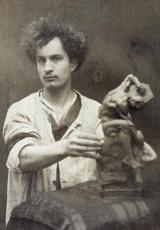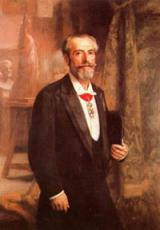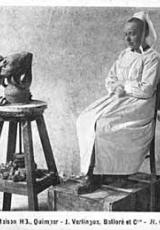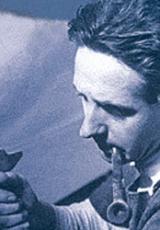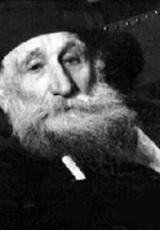Les monuments aux morts, des oeuvres d'art au service du souvenir

After the bloodbaths of the summer of 1914, and even more so after 1918, there was a constant ”revisiting” of those who died in battle, who were commemorated ad infinitum: the fervour of wartime persisted in the confusion of memory. Every single serviceman was remembered by his family, his village, his parish, his workplace and by the State, through its representatives during national or local remembrance events: every elective or administrative department turned its representative into a spokesman for mourning during the twenties and thirties, whether he was an ex-serviceman or not. The words spoken publicly in speeches or in private in prayers and poems, in the images conjured up through inscriptions and commemorative monuments, in stained glass windows and in cemeteries and ossuaries have for the most part carried on up to the present day. From 1918 until the mid 1920's, the 1,400,000 French who died thus took hold of the nation in both a symbolic and emotional way. The grandiose ceremonies and the construction of monuments to the dead turned this mass, private mourning into a State affair, where the oppression of grief came to be expressed much more than the joy of victory. The circles of suffering that could be traced around all servicemen throughout the duration of the conflict, from their close friends to more distant acquaintances, persisted in circles of grief.
The 11th of November, the anniversary of the end of the war, became a day of contemplation (1). Whilst the religious connotation of the 11th of November had a certain affinity with the Catholic liturgy, November being the month of mourning in this calendar, it also allowed the foundation of a genuine secular religion.
At 11 O' Clock, the gatherings around the monuments to the dead, the flags, the black crêpe, the flowers and the speeches all created a vehicle for moral and civic education. Participants came to the ceremonies because they were affected by their experiences of war, or because they wanted to share them, like the children who spoke the refrain ”Dead for France” as a secular amen in response to the names of those who died. The dead and ex-servicemen, husbands and widows, fathers and orphans, were all united in the symbolism of the cortège and the minute's silence. The speeches were almost always in the form of a diptych: thanks to those absent, life could continue. To pay tribute to the lost generation, a sombre series of markers was thus established: a symbol of time, the 11th of November; a symbol of place, the monument to the dead; a symbol of action, the commemorative ceremony. The whole of France became an altar to the war and the lost generation. There are two types of remembrance sites: some have been erected on battlefields, the very places where the deaths occurred, whilst others are in places, shared and individual, national and local, public and private, secular and religious, where those who died originated. In the places where they worked, loved, studied and prayed, where they led their lives, symbols of remembrance have sprung up, bearing witness to death and mourning in every private and public area of the country and its colonies.
Global remembrance of a global war
Although the monuments to the dead are often places where we can identify with our heroes and places that justify their sacrifices, they are primarily the sculptors' interpretations of their commissions, which would later serve those taking part in the ceremonies. The depictions featured on them are essential: the monuments are constructed, sculpted works, which have a specific place in the rural or urban landscape. The monuments also recall a history that is at the same time political, economic and social, about mankind, representation and art.
The concept of constructing monuments was born during the war itself; lists displayed in town halls were not enough. France refused to adopt certain forms of commemoration, such as scholarships, village assembly rooms and stadia, which were very common in other countries. For the Republic, remembering the dead had to be represented by a statue erected in the middle of a public area. A certain number of such monuments had already been erected between 1871 and 1914 to commemorate those who died in the Franco-Prussian war. After 1918, they adorned practically every commune, around 36,000 in total. But this figure must be multiplied by at least four or five to give an idea of the commemorative frenzy of the 1920's: everyone who had died had the right to have his name inscribed publicly, not just in his commune, but also, in a more private way, in his work place, school or parish etc. And the front rooms of millions of households were turned into family altars where photographs and souvenirs were displayed.
For the local cenotaph, in most cases a stele in the shape of a pyramid or obelisk was chosen, like those that had up until then adorned graves in cemeteries. This type of monument was the cheapest and in keeping with the spirit of the time. For architects, marble masons and funeral parlours it was the sale of the century! Some astute merchants produced catalogues where you could choose the palm leaves or soldier motifs to be added to the dressed stone, as well as the words considered to be most suitable for your loss. The terms ”children”, ”dead”, ”hero”, ”war”, ”1914-1918”, ”duty”, ”sacrifice”, ”martyrs” and ” memory” were the most popular. The list of the dead made the impression of melancholy complete. The widely adopted use of alphabetic order emphasised the uniformity, closely resembling that of the military cemeteries where the bodies lay. Naming was the central factor: the use of names recalled the individuals, giving them back their existence, when their death on the battlefield had reduced them to nothing. The monuments to the dead glorified both the servicemen and the civilians on the home front, without whom remaining in the war, physically and psychologically, would have been impossible. The tragic theme of courage, martyrdom and death is a common theme in the monuments and the subjects sculpted, works of art dedicated to remembrance (2).
The number of statues of soldiers (whose affectionate nickname of ”poilus”, dating back to the first days of 1915, is significant) increased, bringing them back to life for their nearest and dearest, with whom they shared a common place of birth or residence or work, or an affection borne from family, school, religious or political ties. Standing on their pedestals, the servicemen are dedicated to continuing for all eternity the exemplary virtuous fight for which they gave their lives. Their war is a sterile one: no mud, no lice, no blood, they are clean and fresh like lead soldiers (3). The ”poilus” of the monuments to the dead play over and again the role that had been their own, the heroic defence of a great cause. These monuments are, however, tombs - empty tombs. And this is where reality steps in again. The cenotaphs were built on top of the bodies, like posthumous tableaux of honour. And since we cannot glorify or exalt death, whatever the cause (is it not always intolerable?), the monuments choose to deny it by representing the soldiers as eternal beings, resurrected in bronze. Sometimes, however, the soldier is shown dead, as a valiant, medieval recumbent statue.
On the top of the monument there is often a cockerel to symbolise the homeland. We may also see civilians, women and children, carrying out their daily tasks on the land or in the factory. This demonstrates how the French held out in three ways: believing, fighting and working. Although the monuments glorify the courage of the survivors and bind them together in the face of their ordeal, they are first and foremost places of sorrow, where mourning and religious and patriotic fervour is second-place.
We see this clearly not just in the local monuments of the more churchgoing regions, but also in the parish monuments of the whole of France. These depictions of war as a kind of tremendous Good Friday, of the front as a Golgotha, turn the soldiers into so many Christs, and Christ into a soldier. In the churches' commemorative stained glass windows, the Christian soldier is linked with the sacrifice of Christ. When the mother of a serviceman finds her son and holds him in her arms, the monument becomes Pietà. These distressed mothers also often provide, through their costumes, a regional touch to the monuments, whether there is an accompanying inscription in Basque or Breton: from the Savoie to the Berry, from Finistère to the Lorraine, the crying women and children share national grief, combined with a local sense of belonging. As for the children admiring or crying over the sacrifice of their fathers, often with the inscription ”To our sons”, they are a reminder of the strange genealogy borne from war: orphaned children and parents deprived of their children, who were still so young.
In the areas ravaged by fighting or the occupation, the monuments appear incriminating. Cathedrals devastated, civilians fleeing, hostages, deported men and women, forced labour and flooded mines: the whole spectrum of the misery of all out war is depicted in Lens, Soissons, Roubaix and Lille.
In depicting the ruins in which soldiers and civilians were taken, we are reminded that, in these regions, the rear lines had become the front lines. In the twenties, it became more a question of denouncing German crimes than emphasising the suffering itself. The time for victimising servicemen and civilians had not yet arrived. Some did their utmost to distort their memories in order to make extraordinary or personal situations more bearable. In the Alsace, soldiers on monuments are often depicted naked: how can you differentiate between a German and a Frenchman without a uniform? So the Pietà of Strasbourg holds the bodies of her two lifeless sons on her knees; the inscription: ”To our dead” omits the phrase: ”for our country”. Which country would it mean, in fact, after an occupation of more than forty years which had gradually became accommodating in a tacit rather than forced way for most of the people of the Alsace and Moselle regions?
Sometimes (about ten examples in France, including Équeurdreville, in the Manche département, and les Lilas) the monuments become overtly pacifist in nature. Here we read: ”Cursed be war!” If such militant monuments are so rare, it is because it was the scale of the grief that dictated the type of monument, rather than the desire to fight to ensure that such a tragedy could never repeat itself. When the monuments were constructed, we were still in shock at the suffering - militant pacifism would come later.
The places where deaths occurred have also been converted into commemorative places, with a network of military cemeteries, landscaped parks/memorials and large battlefield monuments. In memory of the salients of the hardest, most violent offensives, ossuaries have been constructed on the isolated outcrops of death. Whereas the monuments to the dead are empty tombs, the ossuaries contain the remains of thousands, even tens of thousands of men, whose identities have been consumed by the ground and fire. Local monuments, like those in parishes and villages, show the names, but the whereabouts of the bodies is unknown; the ossuaries are packed with bodies whose names are unknown. We were thus witness to a real ”display” of mourning during the post-war years. Likewise, servicemen's, veteran's and pacifist movements, pilgrimages to the graves and battlefield tourism have now become aspects closely linked with the continued interest in mass death. The monuments to the dead are a key means of representing the suffering of grief, whereby we can continue to understand the tragic past of 1914-1918 from generation to generation.
Notes (1) It became a public holiday, not without controversy, from 1922. (2) In Le Temps retrouvé, Marcel Proust makes his character Robert de Saint-Loup say, just before his death on the front: ”Rodin or Maillol could create a masterpiece with a terrible subject that we would not recognise... I sense the ”poilu” is already fit for the great poets, like the words flood, Christ, or Barbarians, which were already filled with magnitude before Hugo, Vigny and the rest made use of them” À la recherche du temps perdu, La Pléiade, T. IV, p. 756. (3) Roger Vercel remarked: ”The monument to the dead (...) where the soldier died on his feet, without disturbing a single pleat in his coat and without releasing the flag he held against his heart.” Capitaine Conan, 1934.


